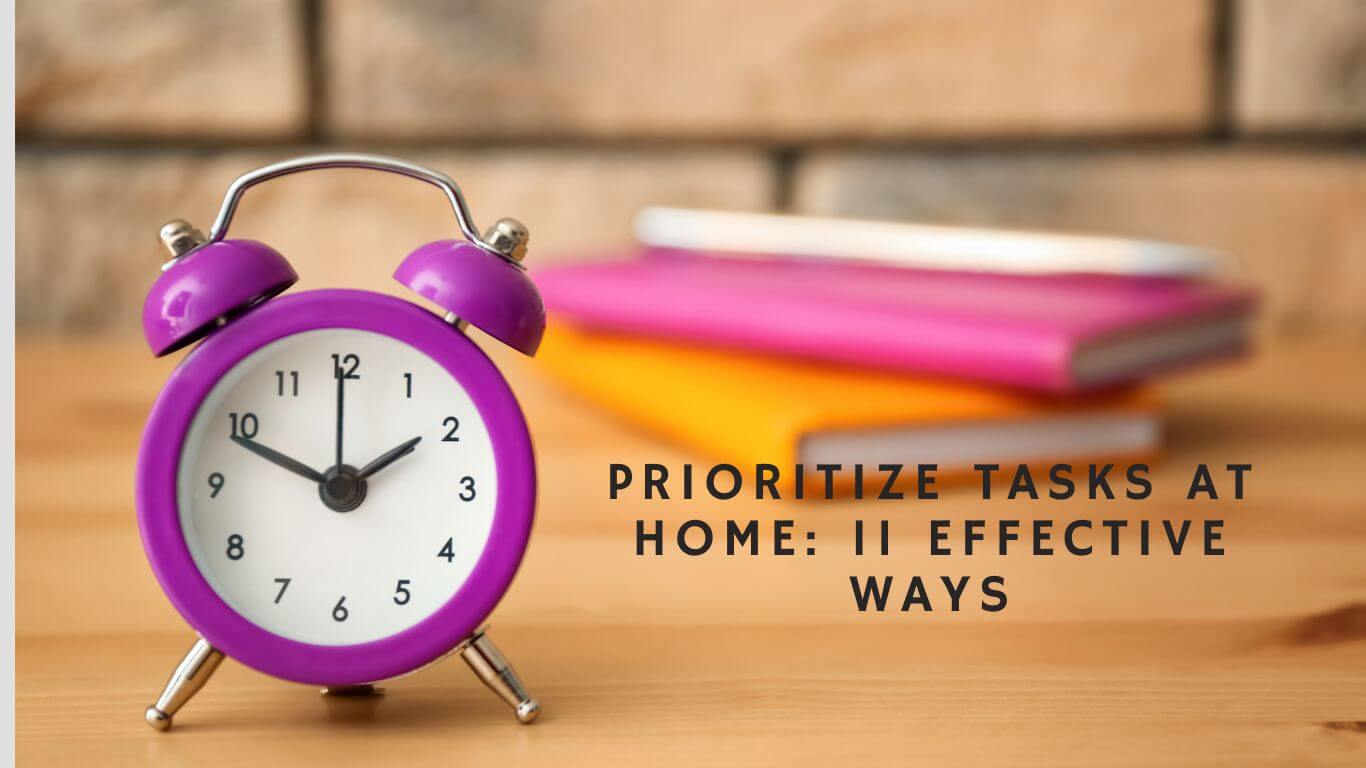Do you often find yourself overwhelmed with a never-ending to-do list at home? It’s time to take control of your tasks and manage your time efficiently.
In this article, we will explore 11 ways to prioritize your tasks effectively, allowing you to achieve balance and productivity. From identifying your most important tasks to utilizing technology and tools, you’ll discover practical strategies to streamline your day and create a sense of belonging in your home.
Get ready to conquer your tasks and reclaim your time!
Identify Your Most Important Tasks
To prioritize your tasks efficiently at home, identify your top priorities. Setting priorities is an essential step in effective time management techniques. By identifying your most important tasks, you can focus your energy and resources on what truly matters, leading to increased productivity and a sense of accomplishment.
Start by making a list of all the tasks you need to complete. Be thorough and include both big and small tasks. Once you have your list, evaluate each task based on its importance and urgency. Ask yourself, ‘Which tasks are crucial for me to complete today?’ and ‘Which tasks can wait until later?’ This will help you determine your top priorities.
Consider the consequences of not completing each task. Are there any deadlines or commitments associated with them? Are there any tasks that, if left undone, would have a significant impact on your personal or professional life? These are the tasks that should be at the top of your priority list.
Another helpful approach is to categorize your tasks based on their level of importance. You can use a simple system, such as assigning tasks to categories like ‘high,’ ‘medium,’ or ‘low’ priority. This will help you visually see which tasks require immediate attention and which ones can be tackled later.
Set Clear and Specific Goals
When it comes to efficient time management at home, setting clear and specific goals is key.
The benefits of goal-setting are numerous, as they provide you with a sense of direction and motivation.
Benefits of Goal-Setting
Set clear and specific goals for yourself in order to experience the benefits of goal-setting when prioritizing tasks for efficient time management at home. By setting goals, you provide yourself with a sense of direction and purpose, which can increase motivation and productivity.
Clear and specific goals help you stay focused and avoid distractions, allowing you to make better use of your time. Here are some benefits of goal-setting:
| Benefits of Goal-Setting |
|---|
| Increased motivation |
| Improved productivity |
| Enhanced focus |
| Reduced procrastination |
| Better time management |
When you set clear and specific goals, you give yourself a roadmap to follow, making it easier to plan and allocate your time effectively. This can help you achieve a sense of accomplishment and satisfaction as you complete each task and move closer to achieving your goals.
So, take the time to set clear and specific goals for yourself, and enjoy the benefits of goal-setting in your journey to efficient time management at home.
Importance of Clarity
Achieving clarity in your goals is essential for effective time management at home. When you have clear and specific goals, you can make decisions more easily and prioritize your tasks accordingly.
Clarity in decision making allows you to focus on what’s truly important and avoid wasting time on unnecessary tasks. It also helps you stay motivated and maintain a sense of direction.
Communication plays a crucial role in achieving clarity. By effectively communicating your goals and expectations with your family members or roommates, you can ensure that everyone is on the same page and working towards the same objectives.
This fosters a sense of belonging and cooperation, making it easier to manage your time efficiently at home.
Specificity Drives Productivity
To boost your productivity, prioritize tasks by setting clear and specific goals. Specificity in goal setting helps you stay focused and motivated, leading to increased efficiency and effectiveness. Here are four reasons why specificity drives productivity:
- Clarity: When you have a specific goal in mind, you know exactly what needs to be done and can create a clear plan of action.
- Focus: Setting specific goals helps you concentrate on the most important tasks, avoiding distractions and unnecessary time-wasting activities.
- Motivation: Clear and specific goals provide a sense of direction and purpose, keeping you motivated and engaged in your work.
- Progress Tracking: Breaking tasks into smaller, specific goals allows you to track your progress more effectively, giving you a sense of accomplishment and boosting your confidence.
Break Tasks Into Smaller, Manageable Chunks
To improve your time management at home, one effective strategy is to break tasks into smaller, manageable chunks. When faced with a large task, such as cleaning the entire house or completing a work project, it can often feel overwhelming and difficult to know where to start.
However, breaking these tasks down into smaller, more manageable pieces can make them feel less daunting and help you prioritize your tasks more effectively.
When you break tasks into smaller chunks, you create a clear plan of action. Instead of trying to tackle everything at once, you can focus on completing one small task at a time. This not only helps you stay organized but also allows you to measure your progress more easily. As you complete each smaller task, you’ll feel a sense of accomplishment and motivation to continue working towards your larger goal.
Breaking tasks into smaller chunks helps to prevent procrastination. When faced with a large task, it’s easy to become overwhelmed and put it off until later. However, by breaking it down into smaller, more manageable pieces, you eliminate the feeling of overwhelm and make it easier to get started.
You can set specific goals for each smaller task and work towards completing them within a designated timeframe.
Incorporating this strategy into your daily routine can greatly improve your time management skills at home. It allows you to prioritize tasks more effectively, work more efficiently, and achieve a greater sense of accomplishment.
Determine Deadlines and Create a Schedule
By determining deadlines and creating a schedule, you can effectively manage your time at home and continue the discussion on prioritizing tasks. Efficient scheduling is crucial for maintaining productivity and achieving your goals.
Here are four key steps to help you determine priorities and create an efficient schedule:
- Identify your top priorities: Take a moment to reflect on your long-term and short-term goals. Determine which tasks align with these goals and are most important to you. By focusing on your priorities, you can avoid getting overwhelmed by less important tasks and stay on track.
- Break tasks into manageable chunks: Once you have identified your priorities, break them down into smaller, actionable tasks. This will make them more manageable and less daunting. Assign specific deadlines to each task to create a sense of urgency and keep yourself accountable.
- Allocate time blocks: Allocate specific time blocks for different tasks or groups of tasks. For example, you can dedicate the morning to important work projects, the afternoon to personal and household tasks, and the evening to relaxation and self-care. By having a structured schedule, you can ensure that every aspect of your life receives the attention it deserves.
- Be flexible but disciplined: While having a schedule is important, it’s equally important to be flexible and adapt to unexpected changes. Life is unpredictable, and tasks may take longer than expected or new tasks may arise. Be willing to adjust your schedule when needed, but also be disciplined in sticking to it as much as possible.
Prioritize Tasks Based on Urgency and Importance
Now, let’s delve into how you can prioritize tasks based on their urgency and importance to effectively manage your time at home. Identifying tasks that are both urgent and important is crucial for efficient time management.
By doing so, you can ensure that you’re focusing your efforts on the most critical activities and avoiding unnecessary stress.
One of the most effective time management techniques is using the Eisenhower Matrix, also known as the Urgent-Important Matrix. This matrix helps you categorize tasks based on their urgency and importance. Start by dividing your tasks into four quadrants:
- Urgent and Important: These are tasks that require immediate attention and have a significant impact on your goals or well-being. Prioritize these tasks and allocate time to complete them as soon as possible.
- Important but Not Urgent: These tasks contribute to your long-term goals and personal development. While they may not require immediate attention, it’s essential to allocate time for them to prevent them from becoming urgent later on.
- Urgent but Not Important: These tasks may seem urgent, but they don’t align with your goals or values. Delegate or eliminate these tasks whenever possible to free up time for more important activities.
- Not Urgent and Not Important: These are tasks that don’t contribute to your goals or well-being. Minimize or eliminate these tasks to focus on what truly matters.
By using the Eisenhower Matrix, you can prioritize tasks effectively and ensure that you’re spending your time on activities that align with your goals and values. It helps you distinguish between what’s urgent and what’s important, allowing you to make informed decisions about how to allocate your time.
Eliminate Distractions and Create a Focused Work Environment
To create a focused work environment, start by decluttering your workspace. Remove any unnecessary items that may distract you from your tasks.
Additionally, set boundaries with technology to minimize interruptions. Turn off notifications on your phone or computer and designate specific times for checking emails or social media.
Lastly, designate a dedicated workspace where you can work without distractions. This could be a separate room, a specific corner of a room, or even a designated desk.
Declutter for Better Focus
Clear your workspace of unnecessary items to eliminate distractions and create a focused work environment. Decluttering your workspace is essential for better focus and productivity. Here are some decluttering tips and organizing strategies to help you create a more efficient work environment:
- Remove any items that aren’t essential to your work. Keep only the tools and materials you need within arm’s reach.
- Implement a filing system to organize your paperwork and documents. Use folders, labels, and color-coding to easily locate and access important files.
- Minimize visual distractions by tidying up cables, wires, and loose papers. Use cable organizers and desk trays to keep everything neat and organized.
- Regularly declutter and clean your workspace to maintain a clutter-free environment. Set aside a few minutes each day to tidy up and put things back in their designated places.
Set Boundaries With Technology
To eliminate distractions and create a focused work environment, establish boundaries with technology. Setting technology boundaries is crucial for avoiding distractions and improving productivity. When working from home, it’s easy to get sidetracked by social media notifications, emails, and other digital distractions.
When you create a clear separation between work and leisure activities on your devices, you can stay focused on your tasks and avoid unnecessary interruptions. Here is a simple table that can help you set technology boundaries:
| Technology Boundaries | Examples |
|---|---|
| Designated work hours | 9 AM-5 PM |
| Turn off non-essential notifications | Social media, email |
| Use website blockers | Block distracting websites |
| Create a dedicated workspace | Separate from leisure areas |
Designate a Dedicated Workspace
Create a focused work environment and eliminate distractions by designating a dedicated workspace. This will help you stay organized and increase your productivity while working from home.
Here are four important steps to consider when creating a comfortable workspace and organizing your workspace essentials:
- Choose a quiet area: Find a space in your home that’s away from noise and distractions. This could be a spare room, a corner in your living room, or even a closet that you can convert into a mini office.
- Invest in a comfortable chair and desk: Make sure you have a chair and desk that are ergonomically designed to support your posture and prevent any discomfort or strain on your body.
- Organize your supplies: Keep your workspace clutter-free by organizing your essentials such as pens, notebooks, and files. Use storage solutions like shelves, drawers, or desk organizers to keep everything in its place.
- Set boundaries: Establish clear boundaries with your family members or roommates to avoid interruptions during your work hours. Communicate your schedule and expectations to ensure a focused work environment.
Delegate Tasks When Possible
One effective way to prioritize tasks for efficient time management at home is by delegating tasks whenever possible. Delegating tasks not only helps to lighten your workload but also allows you to focus on more important or time-sensitive tasks.
It’s important to remember that you don’t have to do everything yourself. By delegating tasks to others, you can free up your time and energy for the tasks that require your expertise or attention.
To delegate tasks effectively, start by identifying tasks that can be easily done by someone else. These tasks could include household chores, such as cleaning, laundry, or grocery shopping. Once you have identified these tasks, consider who you can delegate them to.
This could be your spouse, children, or even hiring help if necessary. By involving others in the household, you not only distribute the workload but also foster a sense of belonging and shared responsibility.
When delegating tasks, it’s important to clearly communicate your expectations and provide any necessary instructions or guidance. This will ensure that the tasks are completed to your satisfaction and in a timely manner.
It’s also important to trust the person you’re delegating the task to and give them the freedom to complete it in their own way, as long as the end result meets your expectations.
Delegating tasks not only helps to manage your time more efficiently but also promotes a sense of teamwork and collaboration within the household. By sharing the responsibilities, everyone can contribute to maintaining a well-functioning and organized home.
Remember, you don’t have to do it all on your own – delegate tasks and enjoy the benefits of effective task management.
Use Technology and Tools to Streamline Tasks
Maximize your productivity by utilizing technology and tools to streamline tasks. In today’s digital age, there are numerous resources available to help you create streamlined processes and achieve an efficient workflow. Here are four ways you can leverage technology and tools to optimize your time management at home:
- Task Management Apps: Take advantage of task management apps like Todoist, Trello, or Asana to organize and prioritize your tasks. These apps allow you to create to-do lists, set deadlines, and track your progress. By keeping all your tasks in one place, you can easily manage and complete them in a systematic manner.
- Calendar Integration: Sync your task management app with your calendar to create a seamless workflow. This integration allows you to allocate specific time slots for each task, ensuring that you have a structured schedule and can allocate time for essential activities. With calendar reminders, you can stay on top of your tasks and never miss a deadline.
- Automation Tools: Use automation tools such as IFTTT (If This Then That) or Zapier to automate repetitive tasks. These tools allow you to create triggers and actions that automate processes across different platforms. For example, you can set up an automation to save email attachments directly to your cloud storage, eliminating the need for manual file transfers.
- Collaboration Platforms: When working on group projects or tasks, collaboration platforms like Google Docs, Microsoft Teams, or Slack can significantly improve your efficiency. These platforms allow real-time collaboration, document sharing, and instant communication, making it easier to work together with others and ensure a smooth workflow.
Practice Effective Time-Blocking Techniques
To effectively manage your time at home, it’s important to practice effective time-blocking techniques.
Time-blocking allows you to allocate specific time periods for different tasks, helping you stay focused and organized.
Benefits of Time-Blocking
Make your time management more efficient at home by practicing effective time-blocking techniques. Time-blocking is a strategy that involves scheduling specific blocks of time for different tasks or activities.
By implementing this technique, you can experience several benefits:
- Improved focus: By allocating dedicated time slots for each task, you can concentrate on one task at a time, minimizing distractions and increasing productivity.
- Better organization: Time-blocking helps you prioritize tasks and allocate sufficient time for each one, allowing you to stay organized and complete tasks in a timely manner.
- Reduced procrastination: When you have a clear plan and schedule, it becomes easier to avoid procrastination and stay motivated to complete your tasks.
- Increased work-life balance: By effectively managing your time, you can create a balance between your work and personal life, ensuring that you have time for relaxation and leisure activities.
Tips for Effective Time-Blocking
How can you effectively implement time-blocking techniques to improve your productivity and time management at home?
Time-blocking is a powerful tool that can help you stay focused and organized. Here are some tips to make your time-blocking more effective:
- Start by identifying your priorities and goals for the day. This will help you allocate your time accordingly.
- Break your day into blocks of time, assigning specific tasks or activities to each block. Be realistic and allow for breaks and downtime.
- Use a digital or physical planner to visually map out your time blocks. This will help you see your schedule at a glance and ensure you don’t double-book yourself.
- Stick to your schedule as much as possible. Treat your time blocks as appointments and avoid distractions.
Take Breaks and Allow for Rest and Recharge
Prioritize taking breaks and allowing for rest and recharge to efficiently manage your time at home. It might seem counterintuitive, but taking breaks throughout the day can actually increase your productivity and help you accomplish tasks more efficiently. Here are four reasons why rest and recharge are crucial for effective time management:
- Increased focus: When you work for extended periods without breaks, your attention starts to waver, and you become less focused. Taking short breaks allows your brain to relax and recharge, making it easier to maintain concentration when you return to your tasks.
- Reduced stress: Continuous work without breaks can lead to burnout and increased stress levels. By taking regular breaks, you give yourself time to step away from your responsibilities and engage in activities that help reduce stress, such as going for a walk, practicing mindfulness, or spending time with loved ones.
- Enhanced creativity: Rest and recharge provide an opportunity for your mind to wander and make unexpected connections. Stepping away from your tasks for a while allows your brain to generate fresh ideas and creative solutions to problems.
- Improved overall well-being: Prioritizing breaks and rest not only helps with time management but also contributes to your overall well-being. Taking care of yourself by allowing time for relaxation and recharge promotes better mental and physical health, leading to increased productivity in the long run.
Remember, breaks aren’t a waste of time but an essential component of effective time management. By incorporating regular breaks into your daily routine, you can maintain focus, reduce stress, boost creativity, and improve your overall well-being.
Regularly Review and Adjust Your Task List and Priorities
Ensure that you regularly assess and modify your task list and priorities for efficient time management at home.
Adjusting priorities is an important step in staying organized and ensuring that you’re focusing on the most important tasks. By regularly reviewing and adjusting your task list, you can stay on track and avoid feeling overwhelmed.
One of the most effective task management techniques is to prioritize tasks based on their importance and urgency. This can be done by categorizing tasks into different levels of priority, such as high, medium, and low. By doing this, you can ensure that you’re tackling the most important tasks first and not wasting time on less important ones.
Another helpful technique is to regularly reassess your task list and remove or delegate tasks that are no longer necessary or can be done by someone else. This will help free up your time and allow you to focus on tasks that require your attention.
It is also important to be flexible and adjust your priorities as needed. Circumstances can change, and new tasks may arise that require immediate attention. By regularly reviewing your task list, you can adjust your priorities accordingly and ensure that you’re staying on top of what needs to be done.
Conclusion
By implementing these 11 strategies for prioritizing tasks, you’ll be able to efficiently manage your time at home.
Identifying your most important tasks, setting clear goals, breaking tasks into manageable chunks, and creating a schedule with deadlines will help you stay focused and organized.
Utilizing technology and tools, practicing time-blocking techniques, and allowing for rest and recharge are also crucial for maximizing productivity.
Regularly reviewing and adjusting your task list and priorities will ensure you stay on track and achieve your goals.













